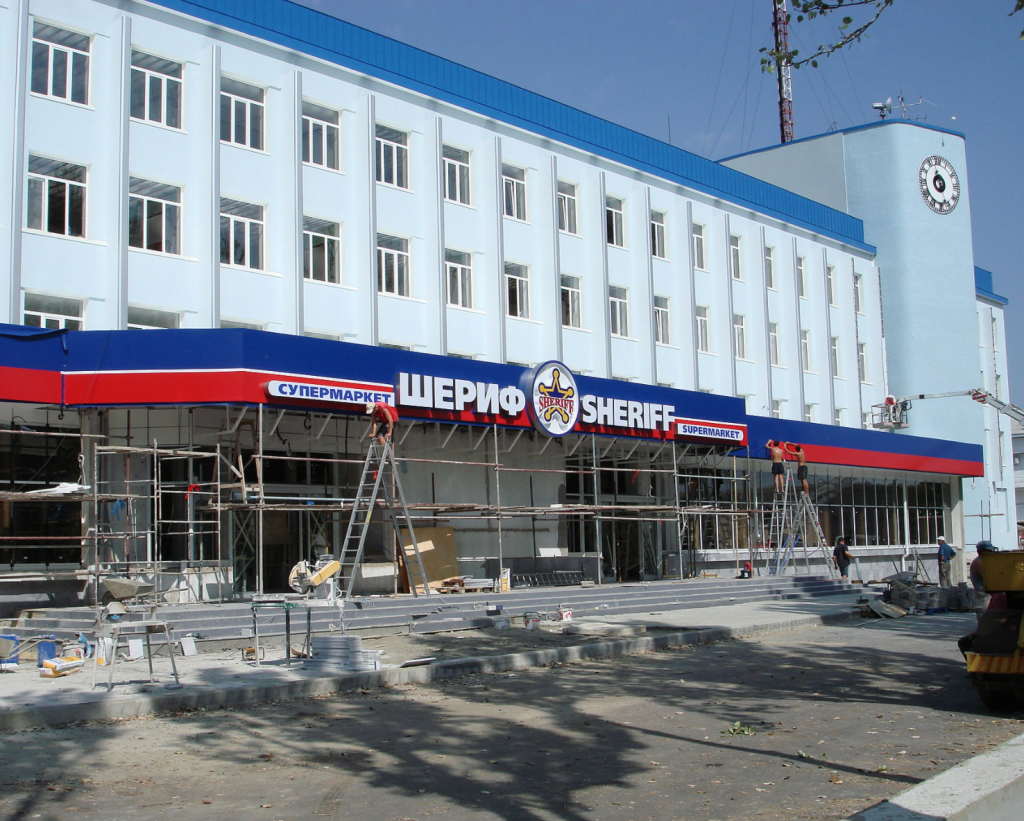Above: A Sheriff Supermarket under construction in Bendery, Transnistria in 2006.
Ion Marandici (Ph.D. Rutgers U) is a researcher studying unrecognized states, wealth inequality, and security issues across Eastern Europe and East Asia.
Parastates or de facto states feature as an overlooked phenomenon in international affairs. A recent study identified thirty-four of them in existence after the Second World War. Their surprising long-term survival raises intriguing questions about the link between the lack of recognition and economic development. How do these rebel regions position themselves in a global environment in which competition for resources and access to markets favor “standard” states? What kind of economic governance models do the insurgents adopt? And where do they find the necessary resources to provide basic public goods?
Researchers and policymakers tend to ignore matters pertaining to rebel governance, preferring instead to focus on the uncertain status and hard security challenges posed by these contested territories. Yet the powerholders governing these areas, much like their peers, pursue economic policies, create regulatory frameworks, construct market institutions, and set up property rights regimes. Some, like Taiwan, are quite successful, attracting foreign talent, innovating, and investing abroad. By contrast, the secessionist regions of the former Soviet borderlands are less prosperous, surviving mostly due to aid from Russia, which acts as their patron state.
To shed light on the resource extraction strategies these rebel regions employ, we might compare the economic strategies adopted in Transnistria and the Donetsk People’s Republic (DPR). Both are heavily industrialized areas that seceded from Moldova and Ukraine, respectively, with significant military help from Moscow.
Their economic models differ, however. An oligarchic system dominated by Sheriff, a private company, has emerged in Transnistria, whereas the DPR insurgents have set up a dirigiste economy entirely dependent on the rent received from their patron state.
Transnistria’s economy revolves around the financial-industrial conglomerate Sheriff — hence its occasional nickname, "the Sheriff Republic." Obviously, at the time of secession, the ruling elites of Transnistria did not set out to transform the economy into a monopoly dominated by Sheriff. On the contrary, early on, Transnistria defined its economy as socially oriented and opposed Mikhail Gorbachev's economic changes.
Privatization occurred only after the region was hit by the 1998 crisis. Foreign entrepreneurs, however, were reluctant to park their capital in an unrecognized jurisdiction. The only ones willing to invest in Transnistria’s Moldova Steel Works in Rybnitsa were several Russian and Ukrainian oligarchs. When they failed to revive the steel mill, Transnistria retook possession of the Soviet-era behemoth.
Russia’s state-owned corporations play a major role in the region's economy. Transnistrian industry, for instance, benefits from subsidized gas it receives from Gazprom. The Cuciurgani power plant, owned by Inter RAO UES, uses cheap natural gas to produce electrical energy and export it to the rest of Moldova. In fact, 77% of Moldova’s electricity needs are satisfied by imports from the secessionist region.
The rise of Sheriff illustrates how private entrepreneurs relying on political ties capture institutions and build businesses based on rent-seeking. By the mid-2000s, Sheriff had established monopolies in multiple sectors, eliminating domestic and foreign competition. It then used its resources to buy political influence. The company began funding parties and MPs in Transnistria’s Supreme Soviet, capturing the economy of the disputed region much like business magnates were capturing the state in Moldova as a whole. Lacking sufficient revenue, Transnistria’s authorities could not tax Sheriff more as its owners opposed such redistributive policies. Still, when the entrenched Smirnov clan was removed from power in 2011, Evgeny Shevchuk, the new incumbent, consolidated the region's fiscal capacity in order to raise more revenue from the private sector. In doing so, Shevchuk lost Sheriff’s support, developed new corruption schemes, and, ultimately, was forced to flee Transnistria.
Not all is doom and gloom with Sheriff, however. Despite the region's contested status, Sheriff invested substantially in its soccer club and built the only world-class stadium in Moldova, bringing in international players and accomplishing remarkable results. FC Sheriff regularly wins Moldova’s soccer championship. The Transnistrian team even managed to beat Real Madrid in the 2021 UEFA Champions League.
By contrast, DPR’s economy remains deeply shaped by a conflict whose initial evolution exemplified the "roving bandit problem" (Mancur Olson). Local warlords began exacting arbitrary fees in the areas they controlled, but could not engage in excessive predation without jeopardizing the residents' allegiance. Eventually, these warlords joined incipient quasi-state structures and became bureaucrats. In this new function, they nationalized assets held by owners who refused to pledge allegiance to and pay taxes in the DPR. The DPR thus constructed its economy by expropriating several oligarchs, among them Rinat Akhmetov, the wealthiest Ukrainian, whose power base was in Donbas.
The result was a dirigiste economy that banned private banking and crediting. Key industrial assets were placed under the management of an external company. Because foreign investors were avoiding the region, DPR elites asked Russian oligarchs to take over the nationalized factories. Yet Russia’s business magnates stayed away, fearing Western sanctions.
In monetary matters, the Donetsk People's Republic is much more reliant on the Russian patron state than is Transnistria. Unlike Transnistria, the DPR adopted the Russian ruble as its currency, depending entirely on the monetary policy implemented by Russia’s Central Bank. By comparison, Tiraspol has its own currency and has even executed its own version of quantitative easing, propping up its exports during the 2015-2016 crisis.
Still, the economic survival of the two parastates depends to some extent on the strategies of their respective parent states. Whereas Moldova adopted a fairly cooperative strategy toward Transnistria, including it in the EU Association Agreement and facilitating the reorientation of its foreign trade toward EU’s markets, Ukraine’s restrictive approach bans trade with the rebels. Accordingly, Donbas coal and steel reach the government-controlled areas of Ukraine and international markets via roundabout routes. Neither approach has had any impact on the political agenda of the rebel regions.
Unfortunately, despite efforts to identify new business opportunities like crypto-mining, Transnistria and the DPR are stuck in unfavorable equilibria conducive to long-term stagnation. The prevalence of non-market mechanisms, monopolies, and external aid in these conflict-ridden areas allows the rebels to persist, but is unlikely to generate sustainable growth anytime soon.



